In the media, the Paleo diet is sometimes criticized for being based on “reenactment” (which is so not true!), for increasing disease risk due its saturated fat and cholesterol content, or harming health due to a deficiency in certain key nutrients (like calcium or carbohydrates). Fortunately, we have solid scientific evidence to battle all of these myths!
Table of Contents[Hide][Show]
A growing number of scientific papers have been published on the topic of Paleolithic nutrition, especially the potential for a Paleo-style diet to reduce risk factors for chronic disease and improve multiple areas of human health. Many of these papers are based on anthropological evidence, animal studies, or observational studies of populations. But, while those forms of research can be very useful and provide important insight, they can’t definitively demonstrate that human beings become healthier by following Paleo principles.
That’s where human trials come to the rescue! More and more human trials of the Paleo diet are being conducted each year, with overwhelmingly positive results demonstrating wide-ranging benefits, including improvements in: blood lipids, body composition, glycemic control, satiation, insulin sensitivity, and various risk factors for chronic disease and obesity (among other things). Let’s take a look at what the scientific literature has to say about the effects of consuming Paleo-style diets in human beings!
Bisht B, et al. “A multimodal intervention for patients with secondary progressive multiple sclerosis: feasibility and effect on fatigue.” J Altern Complement Med. 2014 May;20(5):347-55.
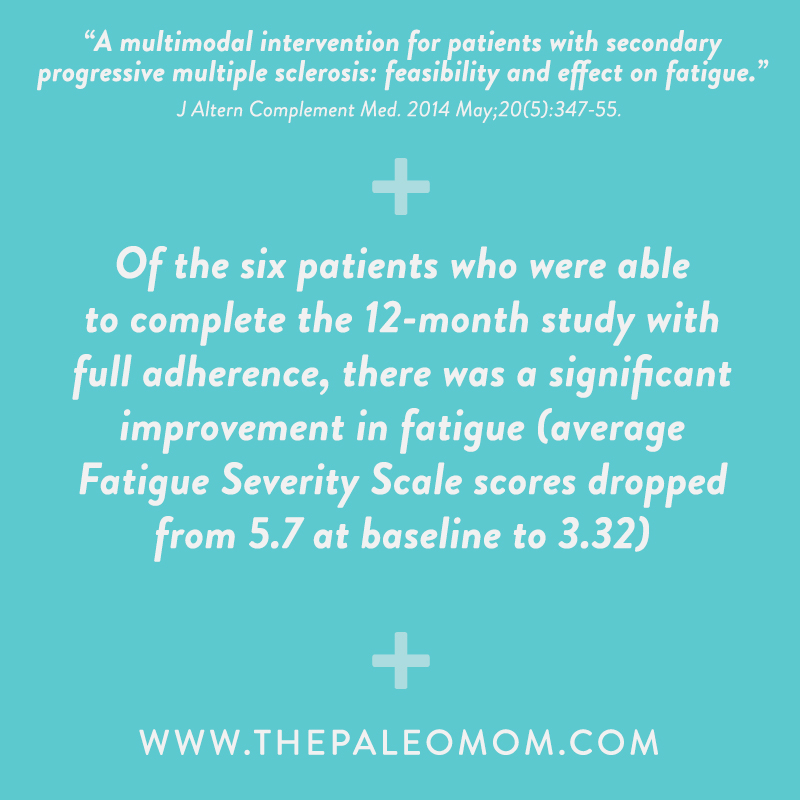 This pilot study was the first of its kind to test how Multiple Sclerosis patients would respond to a modified Paleo diet (green leafy vegetables, sulfur-containing vegetables, intensely colored fruits and vegetables, plant and animal protein, seaweed, and nondairy milks) in combination with supplements, stretching, strengthening exercise, meditation, massage, and electrical stimulation. Of the six patients who were able to complete the 12-month study with full adherence, there was a significant improvement in fatigue (average Fatigue Severity Scale scores dropped from 5.7 at baseline to 3.32 at the end of one year). Given the small sample size and the multiple non-dietary components of the study, the researchers conclude that further evaluation (in the form of additional, larger studies) is warranted.
This pilot study was the first of its kind to test how Multiple Sclerosis patients would respond to a modified Paleo diet (green leafy vegetables, sulfur-containing vegetables, intensely colored fruits and vegetables, plant and animal protein, seaweed, and nondairy milks) in combination with supplements, stretching, strengthening exercise, meditation, massage, and electrical stimulation. Of the six patients who were able to complete the 12-month study with full adherence, there was a significant improvement in fatigue (average Fatigue Severity Scale scores dropped from 5.7 at baseline to 3.32 at the end of one year). Given the small sample size and the multiple non-dietary components of the study, the researchers conclude that further evaluation (in the form of additional, larger studies) is warranted.
Bligh HF, et al. “Plant-rich mixed meals based on Palaeolithic diet principles have a dramatic impact on incretin, peptide YY and satiety response, but show little effect on glucose and insulin homeostasis: an acute-effects randomised study.” Br J Nutr. 2015 Feb 28;113(4):574-84.
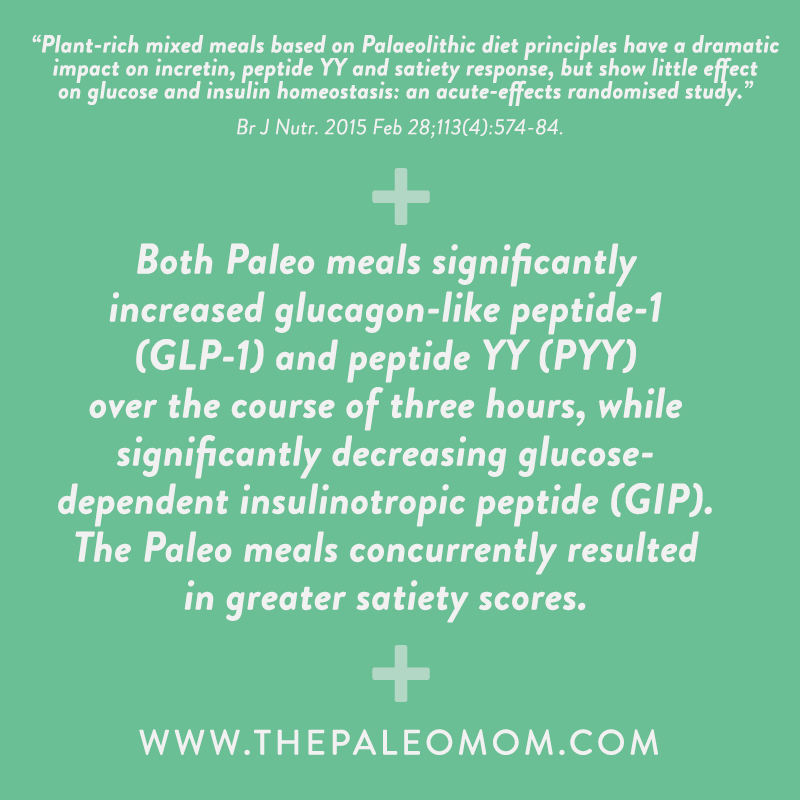 Researchers tested the immediate effects of Paleo foods by designing two Paleo-style meals based on fish and a variety of plants (selected to be high in fiber and phytonutrients). Following a randomized cross-over trial design, study participants were given the two Paleo meals (as well as a third based on WHO guidelines, matched with one of the Paleo meals for total energy, protein, fat, and carbohydrates) at separate times. Compared with the WHO meal, both Paleo meals significantly increased glucagon-like peptide-1 (GLP-1) and peptide YY (PYY) over the course of three hours, while significantly decreasing glucose-dependent insulinotropic peptide (GIP). The Paleo meals concurrently resulted in greater satiety scores. The changes in these gut hormones and satiety reports suggest that meals based on Paleo principles can have beneficial effects on appetite and may potentially reduce the risk of obesity.
Researchers tested the immediate effects of Paleo foods by designing two Paleo-style meals based on fish and a variety of plants (selected to be high in fiber and phytonutrients). Following a randomized cross-over trial design, study participants were given the two Paleo meals (as well as a third based on WHO guidelines, matched with one of the Paleo meals for total energy, protein, fat, and carbohydrates) at separate times. Compared with the WHO meal, both Paleo meals significantly increased glucagon-like peptide-1 (GLP-1) and peptide YY (PYY) over the course of three hours, while significantly decreasing glucose-dependent insulinotropic peptide (GIP). The Paleo meals concurrently resulted in greater satiety scores. The changes in these gut hormones and satiety reports suggest that meals based on Paleo principles can have beneficial effects on appetite and may potentially reduce the risk of obesity.
Blomquist C, et al. “Attenuated Low-Grade Inflammation Following Long-Term Dietary Intervention in Postmenopausal Women with Obesity.” Obesity (Silver Spring). 2017 May;25(5):892-900.
In this 24-month study, researchers randomized 70 obese postmenopausal women to either a prudent control diet or a Paleo-style diet (consisting of lean meat, fish, eggs, vegetables, berries and other fruit, avocado, nuts, and oils). Compared to the prudent control diet group, the Paleo group saw a significantly higher decrease in android fat and high-sensitivity C-reactive protein by the end of the study.
Boers I, et al. “Favourable effects of consuming a Palaeolithic-type diet on characteristics of the metabolic syndrome: a randomized controlled pilot-study.” Lipids Health Dis. 2014 Oct 11;13:160.
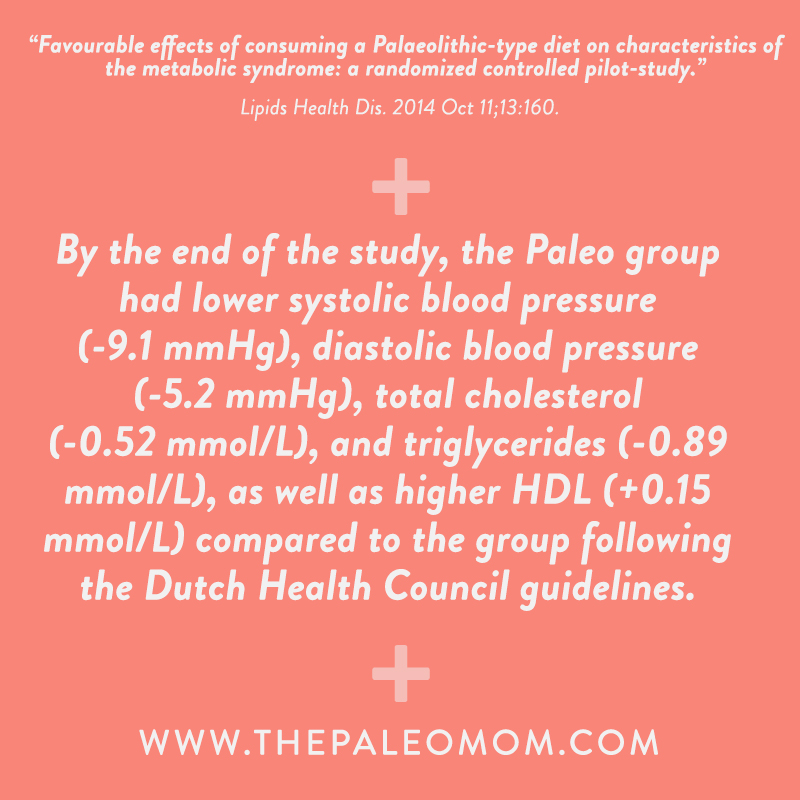 In this pilot study, 32 people with at least two criteria for metabolic syndrome spent two weeks on a Paleo-style diet or an isoenergetic (equal calorie) reference diet based on the guidelines of the Dutch Health Council. By the end of the study, the Paleo group had lower systolic blood pressure (-9.1 mmHg), diastolic blood pressure (-5.2 mmHg), total cholesterol (-0.52 mmol/L), and triglycerides (-0.89 mmol/L), as well as higher HDL (the “good cholesterol”, +0.15 mmol/L) compared to the group following the Dutch Health Council guidelines.
In this pilot study, 32 people with at least two criteria for metabolic syndrome spent two weeks on a Paleo-style diet or an isoenergetic (equal calorie) reference diet based on the guidelines of the Dutch Health Council. By the end of the study, the Paleo group had lower systolic blood pressure (-9.1 mmHg), diastolic blood pressure (-5.2 mmHg), total cholesterol (-0.52 mmol/L), and triglycerides (-0.89 mmol/L), as well as higher HDL (the “good cholesterol”, +0.15 mmol/L) compared to the group following the Dutch Health Council guidelines.
Fontes-Villalba M, et al. “Palaeolithic diet decreases fasting plasma leptin concentrations more than a diabetes diet in patients with type 2 diabetes: a randomised cross-over trial.” Cardiovasc Diabetol. 2016 May 23;15:80.
Nutrivore Weekly Serving Matrix
An easy-to-use and flexible weekly checklist
to help you maximize nutrient-density.
The Weekly Serving Matrix is very helpful! I’ve been eating along these lines but this really helps me know where to focus vs. which foods serve a more secondary role. It’s super helpful and has taken a lot of worry out of my meal planning. Thanks!
Jan
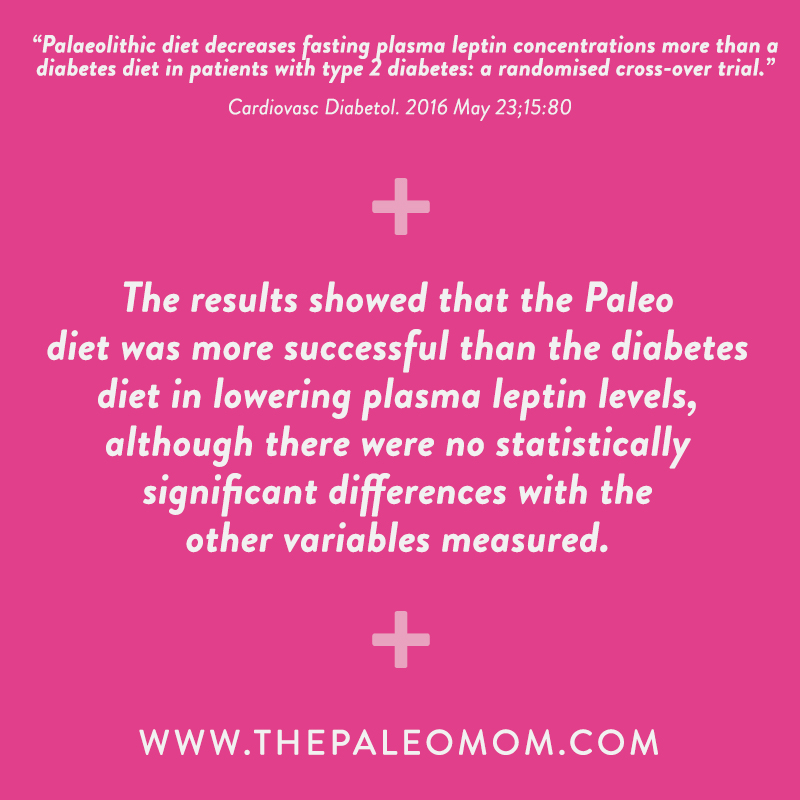 These authors previously reported on a randomized cross-over trial comparing a Paleo diet with a standard diabetes diet in diabetics (with 13 patients enrolled and three months spent in each diet period). In this paper, the researchers reported on fasting plasma concentrations of glucagon, insulin, incretins, ghrelin, C-peptide, and adipokines from the same study. The results showed that the Paleo diet was more successful than the diabetes diet in lowering plasma leptin levels, although there were no statistically significant differences with the other variables measured.
These authors previously reported on a randomized cross-over trial comparing a Paleo diet with a standard diabetes diet in diabetics (with 13 patients enrolled and three months spent in each diet period). In this paper, the researchers reported on fasting plasma concentrations of glucagon, insulin, incretins, ghrelin, C-peptide, and adipokines from the same study. The results showed that the Paleo diet was more successful than the diabetes diet in lowering plasma leptin levels, although there were no statistically significant differences with the other variables measured.
Frassetto LA, et al. “Metabolic and physiologic improvements from consuming a Paleolithic, hunter-gatherer type diet.” Eur J Clin Nutr. 2009 Aug;63(8):947-55.
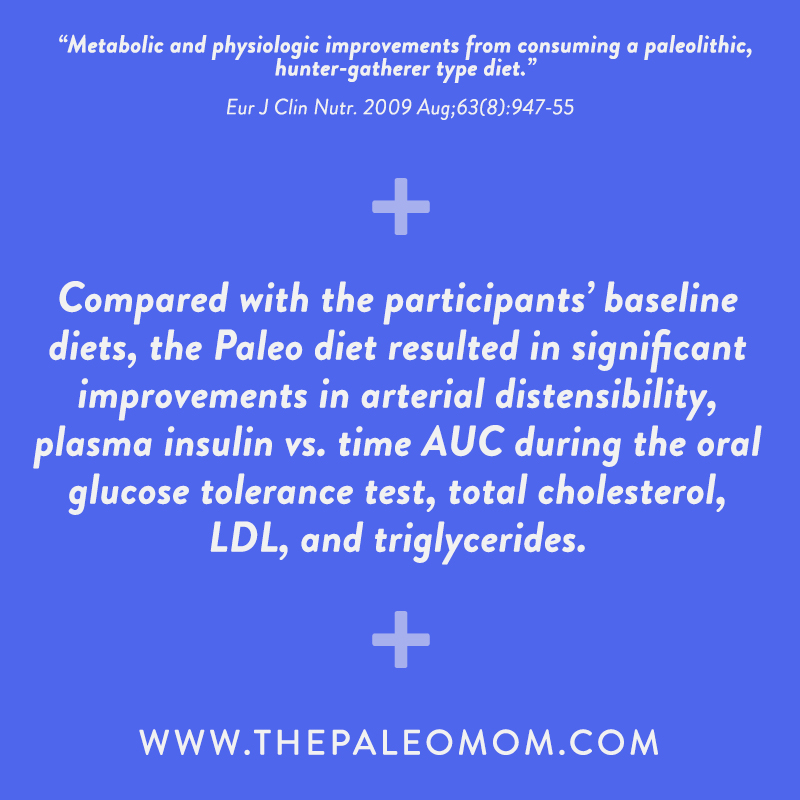 This was a metabolically controlled study where nine healthy, non-obese, sedentary volunteers spent 10 days consuming a Paleo diet consisting of lean meat, fruits, vegetables, and nuts. Compared with the participants’ baseline diets, the Paleo diet resulted in significant improvements in arterial distensibility, plasma insulin vs. time AUC during the oral glucose tolerance test, total cholesterol, LDL, and triglycerides. Although the trial was short-term, the researchers noted that the diet caused nearly consistent improvements in the status of circulatory, carbohydrate, and lipid metabolism and physiology.
This was a metabolically controlled study where nine healthy, non-obese, sedentary volunteers spent 10 days consuming a Paleo diet consisting of lean meat, fruits, vegetables, and nuts. Compared with the participants’ baseline diets, the Paleo diet resulted in significant improvements in arterial distensibility, plasma insulin vs. time AUC during the oral glucose tolerance test, total cholesterol, LDL, and triglycerides. Although the trial was short-term, the researchers noted that the diet caused nearly consistent improvements in the status of circulatory, carbohydrate, and lipid metabolism and physiology.
Genoni A, et al. “Cardiovascular, Metabolic Effects and Dietary Composition of Ad-Libitum Paleolithic vs. Australian Guide to Healthy Eating Diets: A 4-Week Randomised Trial.” Nutrients. 2016 May 23;8(5).
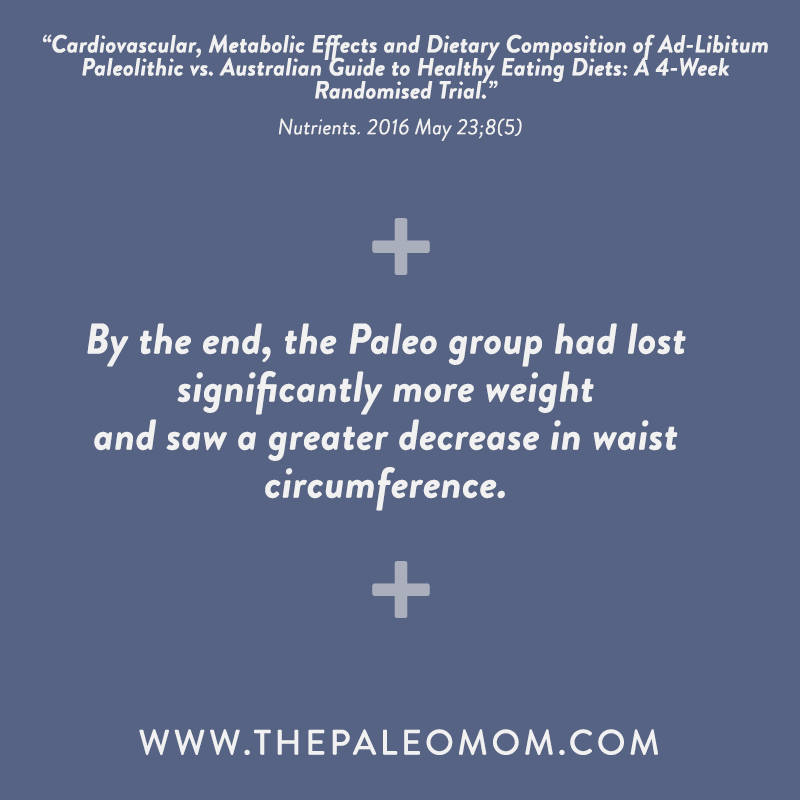 Researchers randomized 39 healthy women to either the Australian Guide to Healthy Eating diet (whole grains, fruit, vegetables, low-fat dairy, and reduced quantities of high-sugar products and refined grains) or a Paleo diet (lean meats, fish, eggs, nuts, fruit, vegetables, olive oil, coconut oil, and almond milk in place of cow milk; no grains, legumes, or dairy). The trial lasted four weeks. By the end, the Paleo group had lost significantly more weight and saw a greater decrease in waist circumference.
Researchers randomized 39 healthy women to either the Australian Guide to Healthy Eating diet (whole grains, fruit, vegetables, low-fat dairy, and reduced quantities of high-sugar products and refined grains) or a Paleo diet (lean meats, fish, eggs, nuts, fruit, vegetables, olive oil, coconut oil, and almond milk in place of cow milk; no grains, legumes, or dairy). The trial lasted four weeks. By the end, the Paleo group had lost significantly more weight and saw a greater decrease in waist circumference.
Jönsson T, et al. “A Paleolithic diet is more satiating per calorie than a mediterranean-like diet in individuals with ischemic heart disease.” Nutr Metab (Lond). 2010 Nov 30;7:85.
 In this study, 29 male patients with ischemic heart disease, impaired glucose tolerance or type 2 diabetes, and a waist circumference greater than 94 cm were randomized to either an ad libitum Paleo diet (lean meat, fish, fruit, vegetables, root vegetables, eggs, and nuts) or a Mediterranean-style diet (whole grains, low-fat dairy products, vegetables, fruit, fish, and oils and margarines) for 12 weeks. The Paleo group reported being equally satiated as the Mediterranean group, but while consuming less energy (indicating the Paleo diet was more satiating per calorie). Leptin levels also decreased more dramatically on the Paleo diet than the Mediterranean diet (31% versus 18% decrease).
In this study, 29 male patients with ischemic heart disease, impaired glucose tolerance or type 2 diabetes, and a waist circumference greater than 94 cm were randomized to either an ad libitum Paleo diet (lean meat, fish, fruit, vegetables, root vegetables, eggs, and nuts) or a Mediterranean-style diet (whole grains, low-fat dairy products, vegetables, fruit, fish, and oils and margarines) for 12 weeks. The Paleo group reported being equally satiated as the Mediterranean group, but while consuming less energy (indicating the Paleo diet was more satiating per calorie). Leptin levels also decreased more dramatically on the Paleo diet than the Mediterranean diet (31% versus 18% decrease).
Jönsson T, et al. “Beneficial effects of a Paleolithic diet on cardiovascular risk factors in type 2 diabetes: a randomized cross-over pilot study.” Cardiovasc Diabetol. 2009 Jul 16;8:35.
 Thirteen patients with type 2 diabetes consumed a standard diabetes diet (whole grains, vegetables, fruits, berries, and lower total fat) and a Paleo diet (lean meat, fish, fruit, vegetables, root vegetables, eggs, and nuts) in a randomized cross-over design, spending three months in each diet period. Compared to the diabetes diet, the Paleo diet resulted in a larger drop in HbA1c (-0.4% units), triglycerides (0.4 mmol/L), diastolic blood pressure (-4 mmHg), weight (-3 kg), BMI (-1 point), and waist circumference (-4 cm). The Paleo diet also boosted HDL levels. Overall, the Paleo diet was more successful than the diabetes diet in terms of improving glycemic control and multiple cardiovascular risk factors.
Thirteen patients with type 2 diabetes consumed a standard diabetes diet (whole grains, vegetables, fruits, berries, and lower total fat) and a Paleo diet (lean meat, fish, fruit, vegetables, root vegetables, eggs, and nuts) in a randomized cross-over design, spending three months in each diet period. Compared to the diabetes diet, the Paleo diet resulted in a larger drop in HbA1c (-0.4% units), triglycerides (0.4 mmol/L), diastolic blood pressure (-4 mmHg), weight (-3 kg), BMI (-1 point), and waist circumference (-4 cm). The Paleo diet also boosted HDL levels. Overall, the Paleo diet was more successful than the diabetes diet in terms of improving glycemic control and multiple cardiovascular risk factors.
Jönsson T, et al. “Subjective satiety and other experiences of a Paleolithic diet compared to a diabetes diet in patients with type 2 diabetes.” Nutr J. 2013 Jul 29;12:105.
 This is a second publication based on Jönsson, et al.’s study of a Paleo diet versus a standard diabetes diet in diabetic patients. The researchers found that compared to the diabetes diet, the Paleo diet resulted in greater satiety quotients for energy per meal (meaning Paleo was more satiating on a per-calorie basis).
This is a second publication based on Jönsson, et al.’s study of a Paleo diet versus a standard diabetes diet in diabetic patients. The researchers found that compared to the diabetes diet, the Paleo diet resulted in greater satiety quotients for energy per meal (meaning Paleo was more satiating on a per-calorie basis).
Lee JE, et al. “A Multimodal, Nonpharmacologic Intervention Improves Mood and Cognitive Function in People with Multiple Sclerosis.” J Am Coll Nutr. 2017 Mar-Apr;36(3):150-168.
This trial assessed how patients with multiple sclerosis responded to a 12-month intervention (consisting of a modified Paleo diet, a stretching and strengthening exercise program, neuromuscular electrical stimulation (EStim), and stress management in the form of meditation and massage). Within just a few months, patients’ anxiety and depression started to improve, followed by positive changes in cognitive function. Although the intervention as a whole was beneficial, the researchers noted that adherence to the modified Paleo diet seemed to be the most important factor for improving mood and cognition.
Lindeberg S, et al. “A Palaeolithic diet improves glucose tolerance more than a Mediterranean-like diet in individuals with ischaemic heart disease.” Diabetologia. 2007 Sep;50(9):1795-807. Epub 2007 Jun 22.
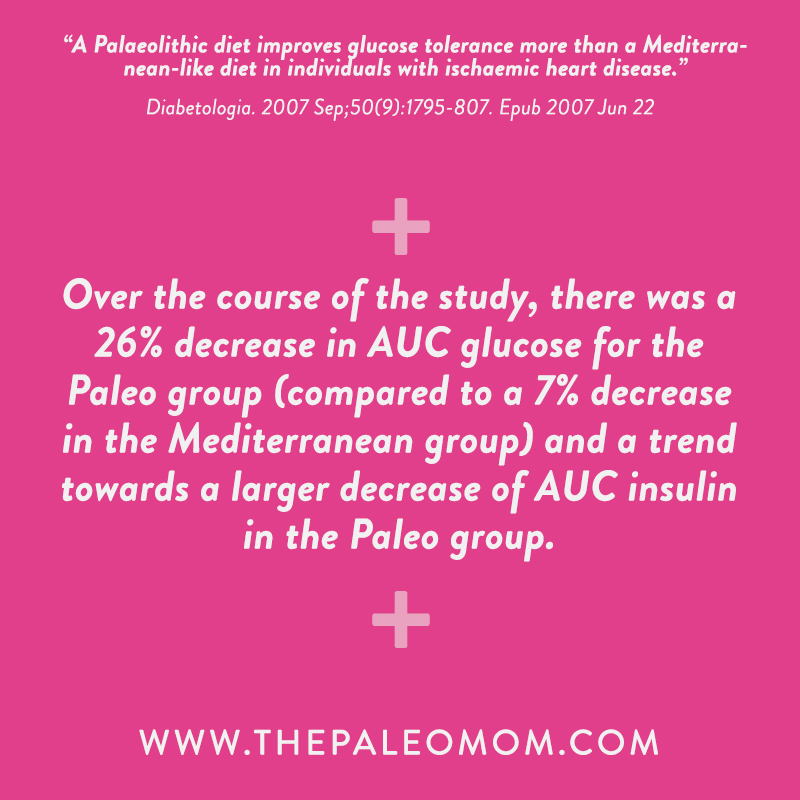 Twenty-nine patients with ischemic heart disease and either glucose intolerance or type 2 diabetes were randomized to either an ad libitum Paleo diet (lean meat, fish, fruit, vegetables, root vegetables, eggs, and nuts) or a Mediterranean-style diet (whole grains, low-fat dairy products, vegetables, fruit, fish, and oils and margarines) for 12 weeks. Over the course of the study, there was a 26% decrease in AUC glucose for the Paleo group (compared to a 7% decrease in the Mediterranean group) and a trend towards a larger decrease of AUC insulin in the Paleo group. The change in AUC glucose was independent of changes in waist circumference.
Twenty-nine patients with ischemic heart disease and either glucose intolerance or type 2 diabetes were randomized to either an ad libitum Paleo diet (lean meat, fish, fruit, vegetables, root vegetables, eggs, and nuts) or a Mediterranean-style diet (whole grains, low-fat dairy products, vegetables, fruit, fish, and oils and margarines) for 12 weeks. Over the course of the study, there was a 26% decrease in AUC glucose for the Paleo group (compared to a 7% decrease in the Mediterranean group) and a trend towards a larger decrease of AUC insulin in the Paleo group. The change in AUC glucose was independent of changes in waist circumference.
Masharani U, et al. “Metabolic and physiologic effects from consuming a hunter-gatherer (Paleolithic)-type diet in type 2 diabetes.” Eur J Clin Nutr. 2015 Aug;69(8):944-8.
 In this study, researchers compared the effects of a Paleo diet (14 participants) with a diet based on the recommendations of the American Diabetes Association (10 participants). The Paleo diet included lean meat, fruit, vegetables, and nuts (while excluding salt), and the ADA diet included whole grains, legumes, low-fat dairy, and moderate levels of salt. After 14 days on the test diets, both groups had improvements in metabolic measures, but the Paleo diet group saw greater improvements in glucose control and lipid profiles. Moreover, the most insulin-resistant participants in the Paleo group experienced a significant increase in insulin sensitivity, whereas the ADA group saw no such benefit.
In this study, researchers compared the effects of a Paleo diet (14 participants) with a diet based on the recommendations of the American Diabetes Association (10 participants). The Paleo diet included lean meat, fruit, vegetables, and nuts (while excluding salt), and the ADA diet included whole grains, legumes, low-fat dairy, and moderate levels of salt. After 14 days on the test diets, both groups had improvements in metabolic measures, but the Paleo diet group saw greater improvements in glucose control and lipid profiles. Moreover, the most insulin-resistant participants in the Paleo group experienced a significant increase in insulin sensitivity, whereas the ADA group saw no such benefit.
Mellberg C, et al. “Long-term effects of a Palaeolithic-type diet in obese postmenopausal women: a 2-year randomized trial.” Eur J Clin Nutr. 2014 Mar;68(3):350-7.
 In this study, 70 obese post-menopausal women were assigned to eat either an ad libitum Paleo diet or a diet based on the Nordic Nutrition Recommendations (NNR) for two years. By six months, both groups had a significant drop in their body fat mass, but the loss was more pronounced in the Paleo diet (although that difference equalized by the end of the study). Waist circumference and sagittal diameter also decreased in both groups, but the decrease was more pronounced in the Paleo group at the six-month mark. Likewise, triglycerides decreased significantly more at both six months and twelve months in the Paleo group compared to the Nordic Nutrition Recommendations group. Importantly, this study shows that the Paleo diet is perfectly safe long-term.
In this study, 70 obese post-menopausal women were assigned to eat either an ad libitum Paleo diet or a diet based on the Nordic Nutrition Recommendations (NNR) for two years. By six months, both groups had a significant drop in their body fat mass, but the loss was more pronounced in the Paleo diet (although that difference equalized by the end of the study). Waist circumference and sagittal diameter also decreased in both groups, but the decrease was more pronounced in the Paleo group at the six-month mark. Likewise, triglycerides decreased significantly more at both six months and twelve months in the Paleo group compared to the Nordic Nutrition Recommendations group. Importantly, this study shows that the Paleo diet is perfectly safe long-term.
O’Dea K. “Marked improvement in carbohydrate and lipid metabolism in diabetic Australian aborigines after temporary reversion to traditional lifestyle.” Diabetes. 1984 Jun;33(6):596-603.
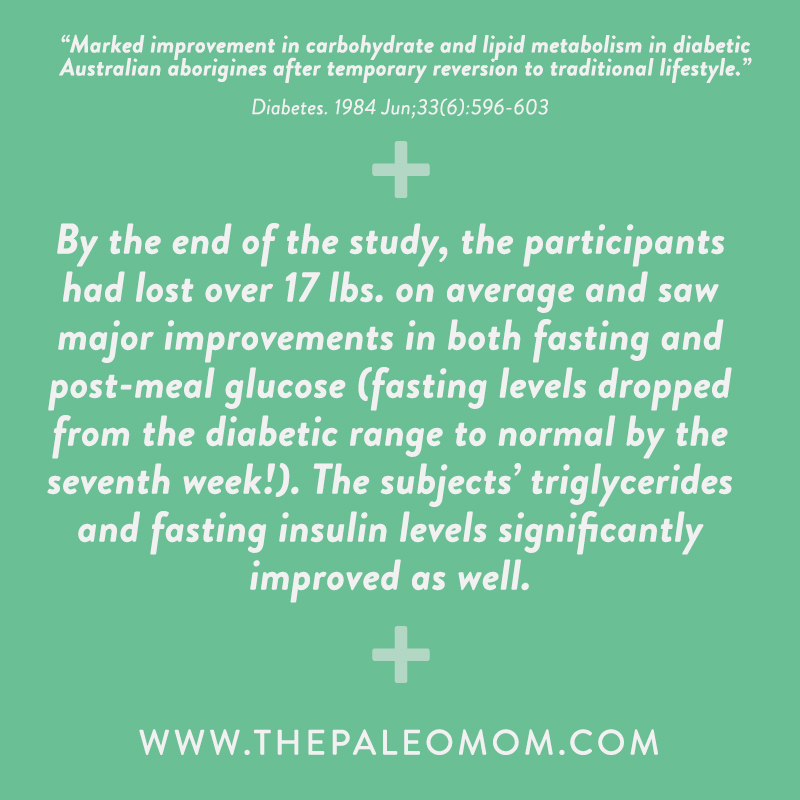 Published in 1984, this is one of the first studies ever testing the effects of ancestral diets! Ten diabetic, overweight Australian Aborigines went from a standard Australian diet to eating only what they could hunt or gather in their native environment: kangaroo, crocodile, yams, figs, honey, turtle, crawdads, beef, and other local foods. (Due to the leanness of wild animals, their diets ended up being high in protein (50 to 80% of calories), low in fat (an average of 13% of calories), and low to moderate in carbohydrates (5 to 33%), with a low overall calorie intake (1200 per day). They also ended up engaging in more physical activity due to a lifestyle switch towards hunting and gathering. By the end of the study, the participants had lost over 17 lbs. on average and saw major improvements in both fasting and post-meal glucose (fasting levels dropped from the diabetic range to normal by the seventh week!). The subjects’ triglycerides and fasting insulin levels significantly improved as well.
Published in 1984, this is one of the first studies ever testing the effects of ancestral diets! Ten diabetic, overweight Australian Aborigines went from a standard Australian diet to eating only what they could hunt or gather in their native environment: kangaroo, crocodile, yams, figs, honey, turtle, crawdads, beef, and other local foods. (Due to the leanness of wild animals, their diets ended up being high in protein (50 to 80% of calories), low in fat (an average of 13% of calories), and low to moderate in carbohydrates (5 to 33%), with a low overall calorie intake (1200 per day). They also ended up engaging in more physical activity due to a lifestyle switch towards hunting and gathering. By the end of the study, the participants had lost over 17 lbs. on average and saw major improvements in both fasting and post-meal glucose (fasting levels dropped from the diabetic range to normal by the seventh week!). The subjects’ triglycerides and fasting insulin levels significantly improved as well.
Osterdahl M, et al. “Effects of a short-term intervention with a Paleolithic diet in healthy volunteers.” Eur J Clin Nutr. 2008 May;62(5):682-5.
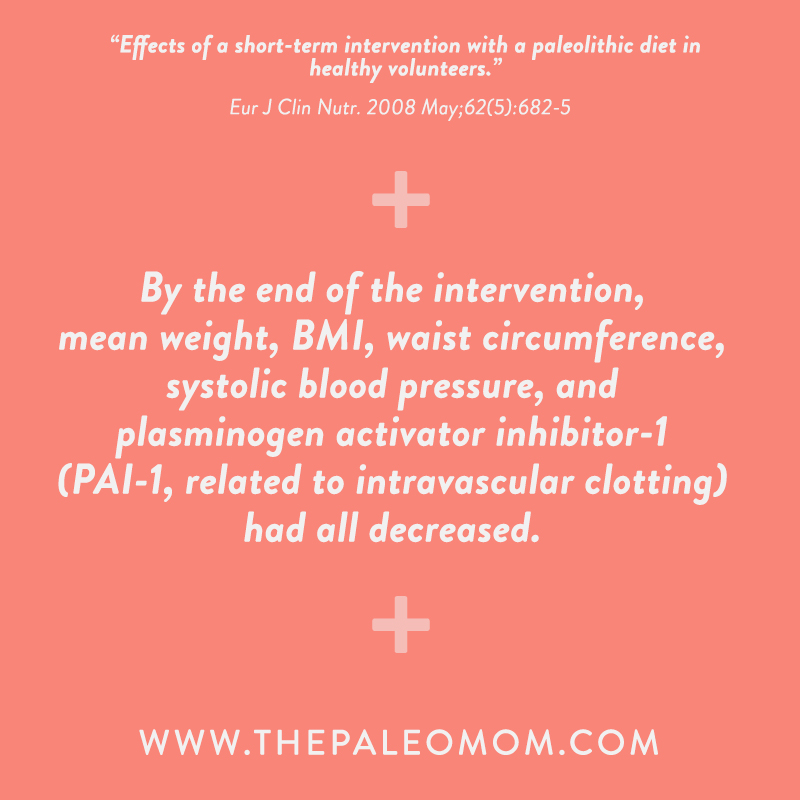 This three-week intervention placed 20 people (14 who successfully finished the study) on a Paleo diet, which included unlimited amounts of: all fresh or frozen fruits, berries, and vegetables except legumes; fresh or frozen seafood with no added salt; fresh or frozen unsalted lean meats and minced meat; unsalted nuts (except peanuts); fresh squeezed lemon or lime juice; flaxseed or rapeseed oil; coffee and tea (without sugar, honey, milk, or cream); and salt-free spices. Potatoes, dried fruit, salted seafood, honey, and cured meats were allowed in moderation, and dairy foods, legumes, grains, preserved meats, canned food (except tomatoes), and foods with refined sugar were all excluded. By the end of the intervention, mean weight, BMI, waist circumference, systolic blood pressure, and plasminogen activator inhibitor-1 (PAI-1, related to intravascular clotting) had all decreased.
This three-week intervention placed 20 people (14 who successfully finished the study) on a Paleo diet, which included unlimited amounts of: all fresh or frozen fruits, berries, and vegetables except legumes; fresh or frozen seafood with no added salt; fresh or frozen unsalted lean meats and minced meat; unsalted nuts (except peanuts); fresh squeezed lemon or lime juice; flaxseed or rapeseed oil; coffee and tea (without sugar, honey, milk, or cream); and salt-free spices. Potatoes, dried fruit, salted seafood, honey, and cured meats were allowed in moderation, and dairy foods, legumes, grains, preserved meats, canned food (except tomatoes), and foods with refined sugar were all excluded. By the end of the intervention, mean weight, BMI, waist circumference, systolic blood pressure, and plasminogen activator inhibitor-1 (PAI-1, related to intravascular clotting) had all decreased.
Otten J, et al. “Benefits of a Paleolithic diet with and without supervised exercise on fat mass, insulin sensitivity, and glycemic control: a randomized controlled trial in individuals with type 2 diabetes.” Diabetes Metab Res Rev. 2016 May 27.
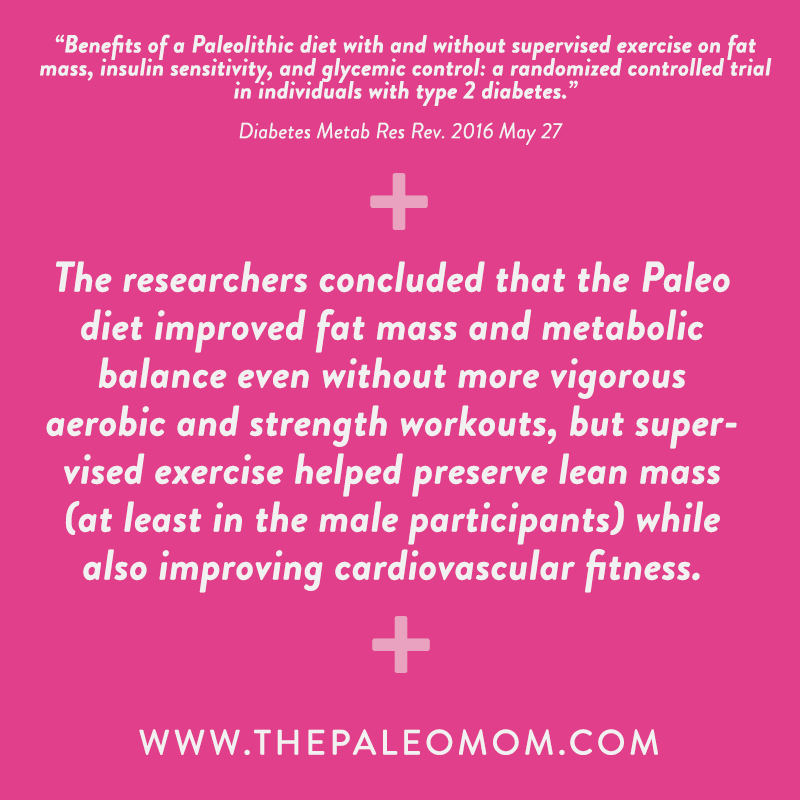 This study featured 32 patients with type 2 diabetes who followed a Paleo diet for 12 weeks, randomized to either a group following standard exercise recommendations or a supervised exercise group (one hour of aerobic exercise and resistance training, three times per week). The Paleo diet was based on lean meat, fish, seafood, eggs, vegetables, fruits, berries, and nuts, while excluding cereals, legumes, refined fats, refined sugars, salt and dairy products. Over the course of the study, the Paleo group with standard exercise lost 5.7 kg of body fat (compared 6.7 kg for the group with supervised exercise), improved insulin sensitivity (HOMA-IR) by 45% (the same as the group with supervised exercise), saw a 0.9% reduction in HbA1c (compared to 1.1% for the group with supervised exercise), and saw a 62% decrease in leptin (compared to 42% decrease for the group with supervised exercise). The researchers concluded that the Paleo diet improved fat mass and metabolic balance even without more vigorous aerobic and strength workouts, but supervised exercise helped preserve lean mass (at least in the male participants) while also improving cardiovascular fitness.
This study featured 32 patients with type 2 diabetes who followed a Paleo diet for 12 weeks, randomized to either a group following standard exercise recommendations or a supervised exercise group (one hour of aerobic exercise and resistance training, three times per week). The Paleo diet was based on lean meat, fish, seafood, eggs, vegetables, fruits, berries, and nuts, while excluding cereals, legumes, refined fats, refined sugars, salt and dairy products. Over the course of the study, the Paleo group with standard exercise lost 5.7 kg of body fat (compared 6.7 kg for the group with supervised exercise), improved insulin sensitivity (HOMA-IR) by 45% (the same as the group with supervised exercise), saw a 0.9% reduction in HbA1c (compared to 1.1% for the group with supervised exercise), and saw a 62% decrease in leptin (compared to 42% decrease for the group with supervised exercise). The researchers concluded that the Paleo diet improved fat mass and metabolic balance even without more vigorous aerobic and strength workouts, but supervised exercise helped preserve lean mass (at least in the male participants) while also improving cardiovascular fitness.
Otten J, et al. “Strong and persistent effect on liver fat with a Paleolithic diet during a two-year intervention.” Int J Obes (Lond). 2016 May;40(5):747-53.
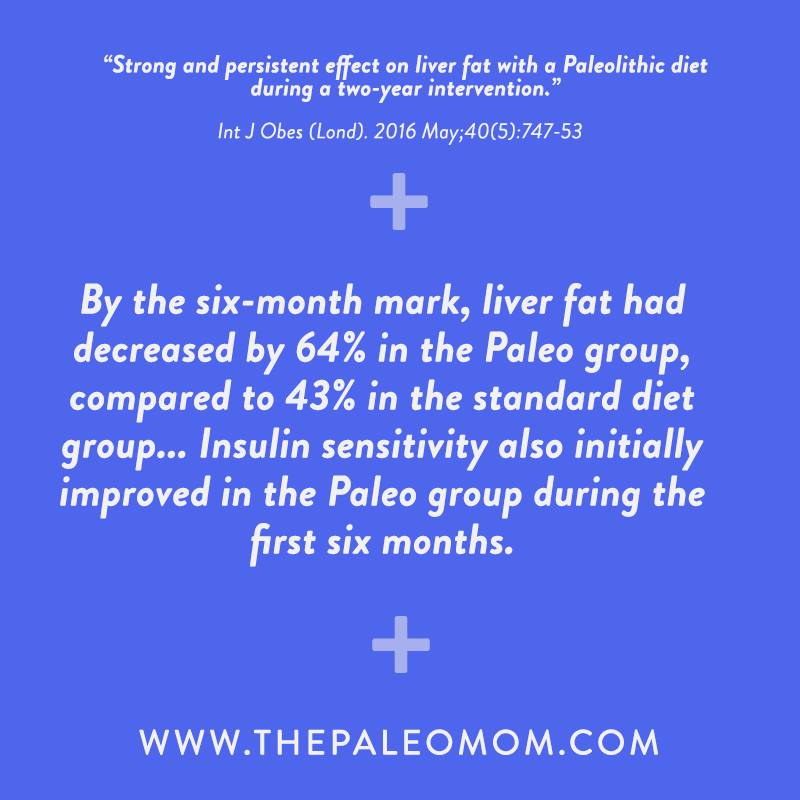 In this study, researchers tested an ad libitum Paleo diet against a standard low-fat diet over the course of two years, documenting changes in liver fat and insulin sensitivity. Seventy healthy, obese, postmenopausal women participated. By the six-month mark, liver fat had decreased by 64% in the Paleo group, compared to 43% in the standard diet group (although after two years, the margin of change was much narrower: a 50% decrease in liver fat in the Paleo group and a 49% decrease in the standard diet group, the good news is that the benefit persisted over quite a long timeframe). Insulin sensitivity also initially improved in the Paleo group during the first six months.
In this study, researchers tested an ad libitum Paleo diet against a standard low-fat diet over the course of two years, documenting changes in liver fat and insulin sensitivity. Seventy healthy, obese, postmenopausal women participated. By the six-month mark, liver fat had decreased by 64% in the Paleo group, compared to 43% in the standard diet group (although after two years, the margin of change was much narrower: a 50% decrease in liver fat in the Paleo group and a 49% decrease in the standard diet group, the good news is that the benefit persisted over quite a long timeframe). Insulin sensitivity also initially improved in the Paleo group during the first six months.
Pastore RL, et al. “Paleolithic nutrition improves plasma lipid concentrations of hypercholesterolemic adults to a greater extent than traditional heart-healthy dietary recommendations.” Nutr Res. 2015 Jun;35(6):474-9.
 Twenty volunteers between the ages of 42 or 60, all with diagnosed high cholesterol levels (hypercholesterolemia), followed an American Heart Association diet for four months, followed by a Paleo-style diet for another four months. After the Paleo period (but not the American Heart Association diet period), average total cholesterol, LDL, and triglycerides dropped significantly, while HDL rose. The improvements were independent of changes in body weight.
Twenty volunteers between the ages of 42 or 60, all with diagnosed high cholesterol levels (hypercholesterolemia), followed an American Heart Association diet for four months, followed by a Paleo-style diet for another four months. After the Paleo period (but not the American Heart Association diet period), average total cholesterol, LDL, and triglycerides dropped significantly, while HDL rose. The improvements were independent of changes in body weight.
Ryeberg M, et al. “A Palaeolithic-type diet causes strong tissue-specific effects on ectopic fat deposition in obese postmenopausal women.” J Intern Med. 2013 Jul;274(1):67-76.
 Ten healthy, non-smoking, post-menopausal women with BMIs greater than 27 were instructed to consume an ad libitum Paleo diet with relatively balanced macronutrients (30% protein, 30% carbohydrate, and 40% fat, mostly from monounsaturated fats). Even without having their food intake restricted, the women lost an average of 10 lbs. in just 5 weeks and spontaneously reduced their calorie intake by 25%. In addition, the participants’ waist-to-hip ratio decreased, their diastolic blood pressure went down, and they saw reductions in their fasting blood sugar, total cholesterol, triglycerides, LDL cholesterol, apolipoprotein B, apolipoprotein A1, urinary C-peptide, and HOMA indices. Levels of intramyocellular lipids didn’t change, but the women’s liver triglyceride levels fell by 49%.
Ten healthy, non-smoking, post-menopausal women with BMIs greater than 27 were instructed to consume an ad libitum Paleo diet with relatively balanced macronutrients (30% protein, 30% carbohydrate, and 40% fat, mostly from monounsaturated fats). Even without having their food intake restricted, the women lost an average of 10 lbs. in just 5 weeks and spontaneously reduced their calorie intake by 25%. In addition, the participants’ waist-to-hip ratio decreased, their diastolic blood pressure went down, and they saw reductions in their fasting blood sugar, total cholesterol, triglycerides, LDL cholesterol, apolipoprotein B, apolipoprotein A1, urinary C-peptide, and HOMA indices. Levels of intramyocellular lipids didn’t change, but the women’s liver triglyceride levels fell by 49%.
Whalen KA, et al. “Paleolithic and Mediterranean diet pattern scores and risk of incident, sporadic colorectal adenomas.” Am J Epidemiol. 2014 Dec 1;180(11):1088-97.
In this case-control study involving 2301 people, researchers analyzed participants’ risk of colorectal cancer based on how closely their eating habits matched a Paleolithic diet pattern or a Mediterranean diet pattern. The researchers calculated scores for each diet pattern by assigning point values to different foods (such as vegetables, fruits, lean meats, fish, and grains and starches), and then assessing which quintile rank each participant fell into for those foods. The calculations revealed that both the Paleolithic and Mediterranean diet patterns appeared to reduce the risk of colorectal adenomas.
Whalen, KA. “Paleolithic and Mediterranean Diet Pattern Scores Are Inversely Associated with Biomarkers of Inflammation and Oxidative Balance in Adults.” J Nutr. 2016 Jun;146(6):1217-26.
This was a pooled, cross-sectional study examining whether adherence to a Paleolithic diet pattern and/or Mediterranean diet pattern was related to levels of inflammation and oxidative stress. After assigning scores to the diets of 646 adults based on how closely they matched the Paleo or Mediterranean pattern, the researchers found that both dietary patterns were associated with lower levels of systemic inflammation and oxidative stress.
Whalen KA, et al. “Paleolithic and Mediterranean Diet Pattern Scores Are Inversely Associated with All-Cause and Cause-Specific Mortality in Adults.” J Nutr. 2017 Apr;147(4):612-620.
Using the results of food frequency questionnaires, researchers analyzed a cohort of 21,423 people to see how closely their diets corresponded to a Paleolithic diet pattern or Mediterranean diet pattern. Over the course of an average of 6.25 years of follow-up, participants in the highest quintile of Paleo or Mediterranean diet scores had a lower risk of all-cause mortality, death from cancer, and death from cardiovascular disease.
A Paleo Meta-Analysis
With so many Paleo trials to choose from, we now have the potential to create meta-analyses (a method for combining data from multiple studies to get a bigger-picture view of results). And, in 2015, one team of researchers did exactly that—with a specific focus on metabolic syndrome! Let’s take a look:
Manheimer EW, et al. “Paleolithic nutrition for metabolic syndrome: systematic review and meta-analysis.” Am J Clin Nutr. 2015 Oct;102(4):922-32.
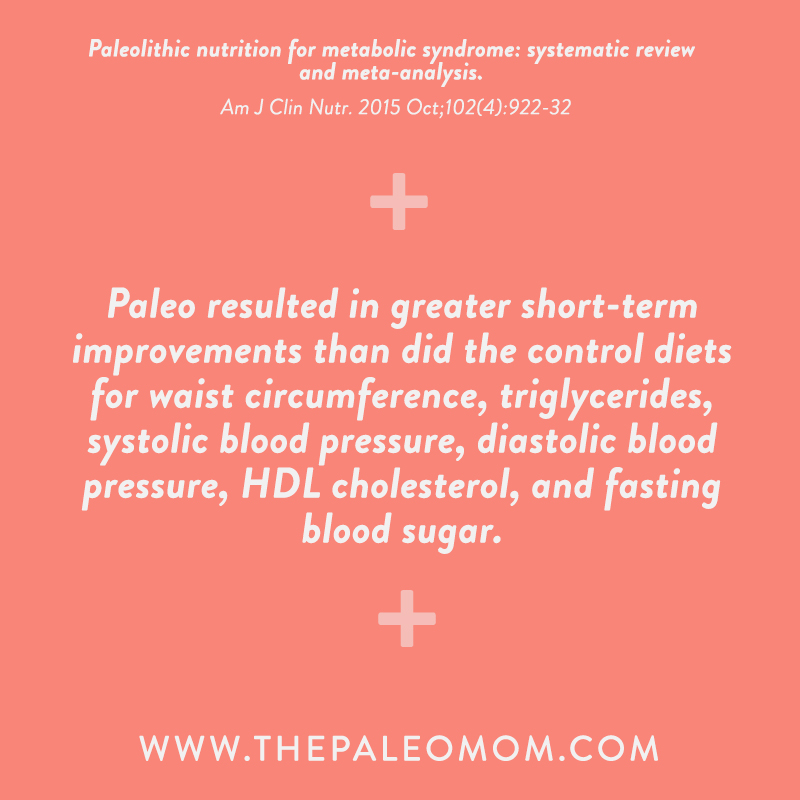 In this study, Manheimer, et al. pooled the results of four randomized controlled trials that compared the Paleo diet to various national food guidelines. The results? Paleo won across the board: Paleo resulted in greater short-term improvements than did the control diets for waist circumference, triglycerides, systolic blood pressure, diastolic blood pressure, HDL cholesterol, and fasting blood sugar.
In this study, Manheimer, et al. pooled the results of four randomized controlled trials that compared the Paleo diet to various national food guidelines. The results? Paleo won across the board: Paleo resulted in greater short-term improvements than did the control diets for waist circumference, triglycerides, systolic blood pressure, diastolic blood pressure, HDL cholesterol, and fasting blood sugar.
Summing it Up
Considering there’s no single “Paleo diet” (just a template of whole foods with a great deal of flexibility), it can sometimes be tricky to extrapolate the results of a particular study to different interpretations of Paleo eating. In fact, many of the studies in the list we just explored have features that aren’t embraced by mainstream Paleo (such as consuming canola (rapeseed) oil—even if only in small amounts, avoiding salt, and choosing only lean meats). However, while smaller details may differ between various interpretations of Paleo, the core elements are what really matter: micronutrient density, relatively balanced macronutrients, and a mixture of both plant and animal foods. In that sense, the results of most of these studies could be expected to hold true for the Paleo framework at large.
Perhaps even more exciting is seeing Paleo consistently outperform therapeutic diets, such as the American Heart Association diet for people with risk factors for cardiovascular disease, the standard dietary recommendations for people with type 2 diabetes, standard low-fat diets, and the Mediterranean diet. And, there has not been a single adverse event reported among any of these studies, including the 2-year long interventions (that’s a long time for a nutrition-based clinical trial and plenty long enough for possible health concerns to be illuminated). So, Paleo earns itself a 5-star safety rating to go along with its best-in-class performance. Vroom!
 So, what does it all mean for us? Undoubtedly, even more robust, bigger and longer clinical trials would be wonderful and there certainly are some in the pipeline. But, if you ever hear/read that Paleo hasn’t been validated by RCCT, you’ve got 19 peer-reviewed published scientific studies above to rebut with. Of course, for those of us who’ve experienced amazing healing, weight loss, and overall well-being from eating Paleo, the results of clinical trials might not seem that important. After all, we already know it works for us! But, to the rest of the world (and because it’s always a good idea to gain deeper understanding of how nutrition affects our bodies), clinical studies are super important for helping Paleo gain legitimacy in the scientific community… and therefore reaching (and benefiting!) even more people.
So, what does it all mean for us? Undoubtedly, even more robust, bigger and longer clinical trials would be wonderful and there certainly are some in the pipeline. But, if you ever hear/read that Paleo hasn’t been validated by RCCT, you’ve got 19 peer-reviewed published scientific studies above to rebut with. Of course, for those of us who’ve experienced amazing healing, weight loss, and overall well-being from eating Paleo, the results of clinical trials might not seem that important. After all, we already know it works for us! But, to the rest of the world (and because it’s always a good idea to gain deeper understanding of how nutrition affects our bodies), clinical studies are super important for helping Paleo gain legitimacy in the scientific community… and therefore reaching (and benefiting!) even more people.











